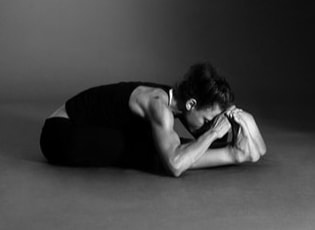 Paschimottanasana with a flat spine Paschimottanasana with a flat spine There are a couple different ways that forward bending postures --- including Paschimottanasana, the seated forward bend --- are taught. Some teach the posture with the back as flat as possible, tilting the pelvis forward significantly, reaching the head toward the feet and perhaps even pulling with the arms. This method (pictured to the left) has become more popular in recent decades with the rise of yoga competitions, yoga photography and the integration of contortion into yoga practice. The other way to execute the posture is to allow the spine to bend forward, perhaps even encouraging it, and placing the head down on the legs near the knees. This is what one might call the "traditional" way to execute the posture. There is evidence for this method in historic yoga texts, ample precedent in the Ghosh lineage, and good reason for it in the body's anatomy. HISTORY Paschimottanasana is one of the oldest postures in the yoga canon, dating back at least 500 years. In the Hatha Yoga Pradipika, one of the foundational texts of hathayoga from about 1500 CE, this posture is instructed as follows: "when one sits with his forehead resting on the thighs, it is called Paschimottanasana."
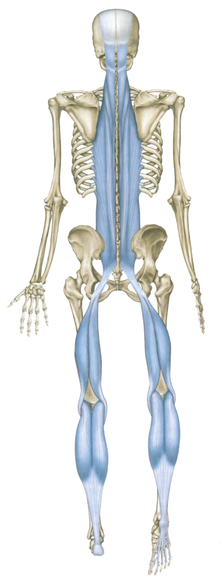 Superficial back line of fascia (from Anatomy Trains) Superficial back line of fascia (from Anatomy Trains) ANATOMICAL Last but not least, there is good anatomical reason for bending the spine in this posture, as opposed to straightening it and reaching the head toward the feet. On the back of the body is a path of connected tissues called the Superficial Backline of fascia. It extends from the toes across the bottoms of the feet, up the backs of the legs across the back of the pelvis, up the back of the spine and neck, and over the top of the skull (pictured left). The physical purpose of Paschimottanasana is to lengthen the back of the body. Its name even means "backside stretch." This includes the feet and calves, the hamstrings, the entire spine and the neck. You can clearly see the connected nature of all these parts in the fascia of the backside. This is why the posture intensifies when you pull your toes back or drop your head. Both actions affect the entire backside of the body. If we practice this posture with a flat spine, we shorten the backside from the pelvis to the head, losing half of the posture and putting extra pressure on the lower half. This lengthens the hamstrings extremely, sometimes leading to hamstring or hip injury, while neglecting length in the spine and the integration of the body as a whole. CONSIDERATION
It is possible that forward bending can be detrimental to bulging, herniated or degenerated discs in the lower spine. In these cases, it is best to avoid bending the spine forward, even skipping postures like Paschimottanasa altogether.
1 Comment
|
AUTHORSScott & Ida are Yoga Acharyas (Masters of Yoga). They are scholars as well as practitioners of yogic postures, breath control and meditation. They are the head teachers of Ghosh Yoga.
POPULAR- The 113 Postures of Ghosh Yoga
- Make the Hamstrings Strong, Not Long - Understanding Chair Posture - Lock the Knee History - It Doesn't Matter If Your Head Is On Your Knee - Bow Pose (Dhanurasana) - 5 Reasons To Backbend - Origins of Standing Bow - The Traditional Yoga In Bikram's Class - What About the Women?! - Through Bishnu's Eyes - Why Teaching Is Not a Personal Practice Categories
All
Archives
May 2024
|


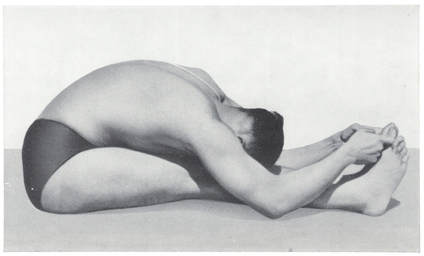
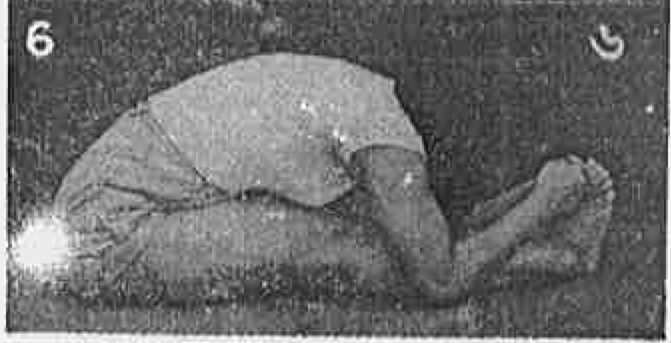
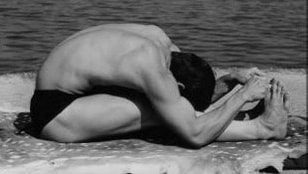





 RSS Feed
RSS Feed